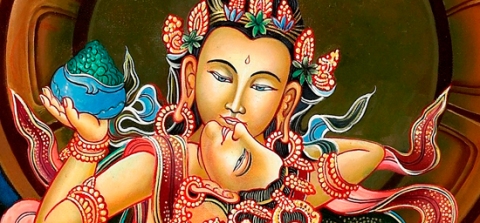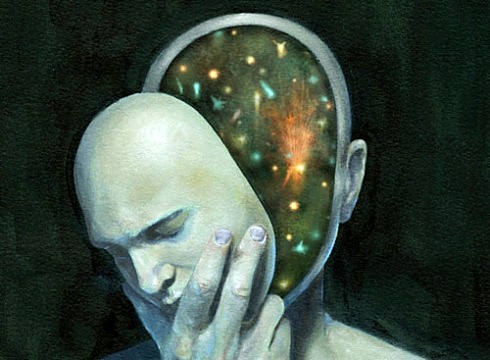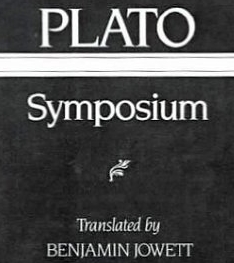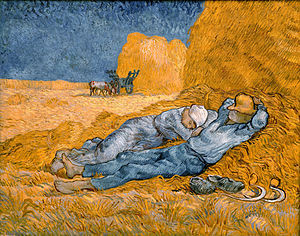
The process of perception received a causal explanation in the hands of the Buddha. For him, this was a problem of prime importance because he realized that all the misery and unhappiness in the world were due to the evils associated with sense perception. The Buddha realized that a proper understanding of the sensory process would give insight into the origin of suffering as well as into the way one can attain freedom from suffering. Hence, the higher life is said to be aimed at understanding the sense organ, the sense object, and sense contact, i.e., sense perception, because it is sense perception that leads to suffering.
The theory of sense perception is represented in the twelvefold formula of causation. The term ayatana, which, to use a word from modern psychology, means ‘gateway’, denotes both the sense organ and the sense object. One of the most important statements concerning the origin of perception from the subject-object relationship follows:
“Depending on eye … and visible form arises visual consciousness; meeting together of the three is contact;because of contact arises feeling or sensation; what one feels, one perceives; what one perceives, one reflects on; what one reflects on, one is obsessed with; what one is obsessed with, due to that, concepts characterized by such obsessed perceptions assail him with regard to visible form cognizable by the eye, belonging to the past, the future, and the present.”
Three important stages in the process of perception can be distinguished from this passage. The formula begins on a very impersonal note and follows the pattern set out in the general formula of causation proposed by the Buddha (“When this exists, that exists or comes to be”). This impersonal manner of description is found only up to the point of feeling or sensation. Then the mode of description, the grammatical structure of the sentences changes to a very personal tone suggestive of deliberate activity. Note the use of the third-person verb: “What one feels or senses, one perceives; what one perceives, one reflects on; what one reflects on, one is obsessed with.” Thus, immediately after feeling, the process of perception becomes one between subject and object. The feeling comes to be looked upon as belonging to a subject. This marks the intrusion of the ego-consciousness, which thereafter shapes the entire process of perception, culminating in the generation of obsessions. These obsessions are threefold: craving, conceit, and dogmatic view. The final stage in this process of perception seems to be different from the preceding two stages. It is no longer a mere contingent process, nor is it an activity deliberately directed, but an inexorable subjection to an objective order of things. At this final stage of perception, he who has hitherto been the subject now becomes as it were a hapless object.
This analysis of the process of perception is of tremendous importance for several reasons. First, it replaces the theory of an eternal and unchanging entity (like the atman) considered to be the subject, with a causal account of the process. Second, while tracing the origin of ego-consciousness to the deliberate activity of the mind, it also accounts for the phenomenon of free will, without which a theory of moral responsibility is untenable. It shows that up to the point of feeling or sensation one is governed by a natural flow of events, a flow in turn governed by the causal pattern. But immediately after that begins deliberate activity, which can lead one either to subjection to the objective order of things, that is, to enslavement to things of the world, or to freedom from bondage to such things through the elimination of ego-consciousness.
Let us examine the problem of free will in Buddhism. The reconciliation of free will with causality has been a perennial problem in philosophy. With regard to the problem of free will in Western philosophy, it is pointed out that the advocates of free will depend on the apparent indeterminacy of the future as compared with the determinacy of the past, because what is foreseen is considered to be fated. Jayatilleke presents another view in explanation of the Buddhist position. He distinguishes between physical and psychological causation and maintains that since causality “is a probability and not a necessity when psychological factors are involved,” one can admit freedom of will.
With regard to the first view, it has been well argued that dependence on future indeterminacy as the basis of a theory of free will is the result of ignorance. That is because “it is plain that no desirable kind of free will can be dependent simply upon our ignorance; for if that were the case, animals would be more free than men, and savages than civilized people. If we are able to recollect some of our past volitions, volitions that have changed the course of our lives, then we would certainly feel we were free in the past. Similarly, we might be free in the future even if we are able to perceive our future volitions. Therefore, the definition of freedom that “our volitions shall be as they are result of our own desires, not of an outside force compelling us to will what we should rather not will” seems to be consistent with the teachings of Buddhism [free will is causally conditioned]. This is possible only if we recognize the causal status of our dispositions and desires, a recognition that points to a Buddhist contribution to Indian thought when viewed in light of the theories propounded by the naturalistic schools current in India during the Buddha’s day.
Jayatilleke quotes two statements from the Pali Nikayas in support of his view that causality “is only a probability, not a necessity, when psychological factors are involved.” The first is, “A person who knows and sees things as they are, need not make an effort of will (saying) ‘I shall become disinterested’; it is in the nature of things that a person who knows and sees becomes disinterested.” This statement implies that causality reigns supreme in the sphere of psychological life. As opposed to this, Jayatilleke quotes another statement that if a person “being ardent, gains knowledge and insight, and because of it, praises himself and disparages others,” he will not progress in spiritual development. Comparing these two statements, one in which causality seems to work and the other in which the same causal process seems to have failed, Jayatilleke concludes that causality is a probability when psychological factors are involved.
Acceptance of such indeterminism in the sphere of psychological causation would seem to go against the Buddha’s theory of the uniformity of mental phenomena. But a careful examination will show that these two statements explain two different causal situations. According to the first statement, causality is a law valid in the sphere of psychological life. In the second example, the individual’s disposition, that is to say, his inclination to be satisfied with the knowledge he has gained, appears to have interfered with the natural process and therefore produced a result that is different from what it would otherwise have been. Thus, the difference between the two examples is that in the case of one a certain causal factor, namely, the disposition to be satisfied, is absent and in the case of the other, it is present. Only if we dismiss the importance of this disposition as a causal factor can we maintain that causality in the present case is merely a probability, not a necessity.
On the contrary, the examples above illustrate very clearly that causality is not incompatible with free will so long as psychological factors such as dispositions are given causal status. In fact, the incompatibility of causation with free will becomes a problem when causation is confined to physical phenomena alone, denying its validity and the causal efficiency of psychic phenomena. It was the knowledge that causality was effective in the past, is effective in the present, and will be effective in the future that enabled the Buddha and his disciples to put an end to suffering and thereby attain perfect happiness and peace. This may have been a very good reason for the inclusion of ignorance of the past as well as of the future under the category of ignorance.
Source: Kalupahana, David J., (1975). Causality: The Central Philosophy of Buddhism, The University Press of Hawaii. pp.122-125














































